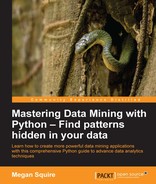Automatic text summarization is a field that is growing in importance as the volume of data in the world increases. There are numerous approaches to text summarization, but all of them rely on the construction of mathematical representations of the words and sentences in a document, then, through extractive or abstractive methods, building a program that can reduce a document to its most important parts. We reviewed three of the common extractive summarization libraries that can be integrated into our Python code: an NLTK-based summarizer, a Gensim-based approach, and a new package called Sumy with its numerous embedded summarizers. We then compared the different approaches to text summarization by using the same text sample and passing it through different summarization algorithms to see how they differed.
It is good that in this chapter, we have begun thinking about what makes an important sentence or a key word. In the next chapter, we will be learning about topic modeling, which means discovering what important topics are being discussed in a text. Many of the same high-level concepts apply to both topic modeling and text summarization, so we should feel quite prepared as we move forward into Chapter 8, Topic Modeling in Text.
